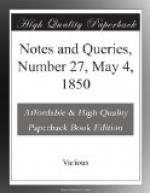Christian Captives.—Where can any information be obtained respecting the Christian captives taken by the Barbary pirates—the subscriptions raised for their relief, by briefs, &c., and what became of the funds?
R.W.B.
Ancient Churchyard Customs.—In an article in The Ecclesiologist on churchyards and churchyard crosses,—but not having the volume by me, I am unable to give an exact reference,—it is stated,
“In them (churchyards) prayers are not now commonly poured forth to God nor are doles distributed to His poor; the epitsphium is no longer delivered from the steps of the churchyard cross, nor does the solemn lamprophoria symbolize the life of the deceased.”
I shall be much obliged for a fuller account of these ancient customs, more particularly of the last two, and for notes of any allusions to them in old books. I may say the same with reference to the following extract from the Handbook of English Ecclesiology, p. 190.:
“Under this head may
also be mentioned the Funa’l or
Deadlight, which was
lighted in some churchyards at night.”
STOKE.
"Rotten Row” and “Stockwell” Street.—“R.R.,” of Glasgow, inquires the etymology of these names, which, occurring both in Scotland and in England, and at a time when the countries were almost always at war, would scarcely have been copied by the one from the other. He rejects, as of course, the etymology of the former from its passing by the buildings which were old and “rotten;” neither does he favour the belief that the original word was “Routine” Row, so called from the processions of the church passing in that direction.
* * * * *
REPLIES.
EARLY STATISTICS.—CHART, KENT.
(No. 21. p. 329.)
The Registrar-General, in his Eighth Report, enters at length into the causes which have brought about the variations in the number of marriages, and consequently, as I need scarcely say, of births. In comparing the marriage returns since 1754, which are given in the report, with the history of events since that period, he certainly makes it clear, to use his own words, that “The marriage returns in England point out periods of prosperity little less distinctly than the funds measure the hopes and fears of the money-market.” (p. 26. 8vo. edit.)
And that
“The great fluctuations in the marriages of England are the results of peace after war, abundance after dearth, high wages after want of employment, speculation after languid enterprise, confidence after distrust, national triumphs after national disasters.” (p. 27.)
During the civil wars, the diminishing influences indicated in the reverse of this statement were at work with an intensity unequalled in any other period of our modern history, so that there can be no doubt




